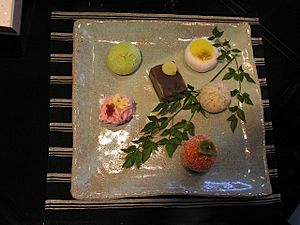Wagashi facts for kids
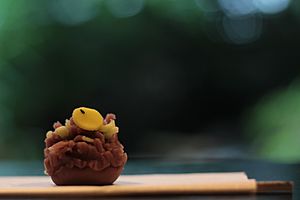
Hotaru (firefly) wagashi
|
|
| Type | Confectionery |
|---|---|
| Place of origin | Japan |
Wagashi (和菓子, wa-gashi) are special traditional Japanese sweets. People often enjoy them with green tea. These treats are usually made from plant-based ingredients like mochi (a type of rice cake), anko (sweet red bean paste), and different fruits.
Contents
What is the History of Wagashi?
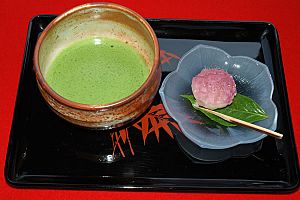
In Japan, the word for sweets, kashi (菓子), originally meant fruits and nuts. Over time, as Japan traded more with China, sugar became a common ingredient in Japanese homes by the end of the Muromachi period.
The art of making wagashi really grew during the Edo period. This was partly because of the introduction of tea to Japan and the influence of Chinese dim sum snacks.
What Kinds of Wagashi Are There?
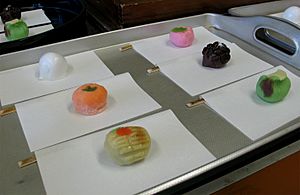
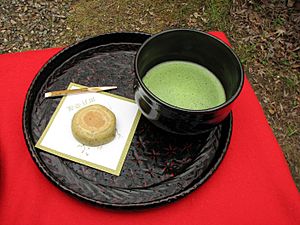
There are many different types of wagashi, each with its own unique taste and look. Here are some popular ones:
- Akumaki: A sweet treat from Kagoshima Prefecture.
- Anmitsu: Chilled cubes of agar jelly (a plant-based gelatin) served with sweet red bean paste and fruit.
- Amanattō: Sweetened azuki beans or other beans that are simmered and then dried.
- Botamochi: A sweet rice ball covered with anko (thick azuki bean paste).
- Daifuku: A general name for mochi (pounded sweet rice) that is filled with anko.
- Dango: Small, sticky, sweet Japanese dumplings often served on a stick.
- Dorayaki: A round, flat sweet made of castella (a sponge cake) wrapped around anko.
- Gokabou: A sweet cake made from rice and sugar.
- Hanabiramochi: A flat, red and white mochi wrapped around anko and a strip of candied gobo (burdock). It looks like a flower petal.
- Imagawayaki (also kaitenyaki): Anko surrounded by a disc of fried dough.
- Kompeito: Small, colorful crystal sugar candies.
- Kusa mochi: "Grass" mochi, which is a sweet mochi flavored with Japanese mugwort (yomogi), usually with an anko center.
- Kuri kinton: A sweet mix of boiled and mashed chestnuts.
- Manjū: Steamed cakes with an an (bean paste) filling, often shaped like fruits or animals.
- Mochi: A chewy rice cake made from glutinous rice.
- Monaka: Anko sandwiched between two delicate and crispy sweet rice crackers.
- Oshiruko (also zenzai): A hot, liquid dessert made from anko soup, often with small mochi pieces floating in it.
- Rakugan: A small, firm, sweet cake made from rice flour and mizuame (a type of liquid sugar).
- Sakuramochi: A rice cake filled with anko and wrapped in a pickled cherry leaf.
- Taiyaki: Similar to imagawayaki, but shaped like a fish, with an anko core inside fried dough.
- Uirō: A steamed cake made of rice flour and sugar, much like mochi.
- Warabimochi: Traditionally made from warabi (a type of fern starch) and served with kinako (roasted soybean flour) and kuromitsu (brown sugar syrup).
- Yatsuhashi: Thin sheets of gyūhi (sweetened mochi), often cinnamon-flavored and folded around red anko.
- Yōkan: One of the oldest wagashi, a solid block of anko made firm with agar and extra sugar.
How Are Wagashi Classified?
Wagashi are grouped based on how they are made and how much moisture they contain. The amount of moisture is important because it affects how long the sweet will stay fresh.
- Namagashi (生菓子) (wet confectionery): These sweets have 30% or more moisture.
- Jō namagashi (上生菓子): Very soft and delicate namagashi that change with the seasons. They often have detailed shapes and colors that show seasonal plants.
- Han namagashi (半生菓子) (half-wet confectionery): These have between 10% and 30% moisture.
- Higashi (干菓子) (dry confectionery): These sweets have 10% or less moisture.
What Makes Wagashi Special?
Making wagashi often requires a lot of skill and effort. These sweets are usually given names inspired by poetry, important historical events, or beautiful natural scenes.
Wagashi are famous for their delicate look and wide variety, which shows the refined culture of Japan.
People often give wagashi as gifts during festivals. They are also a common treat for guests visiting a home. Different regions in Japan have their own special wagashi flavors. It's common for Japanese people to bring wagashi home as souvenirs after trips.
Many Japanese people believe that the artistic design of wagashi represents both the season when they are made and the humble nature of Japanese culture.
See also
 In Spanish: Wagashi para niños
In Spanish: Wagashi para niños


